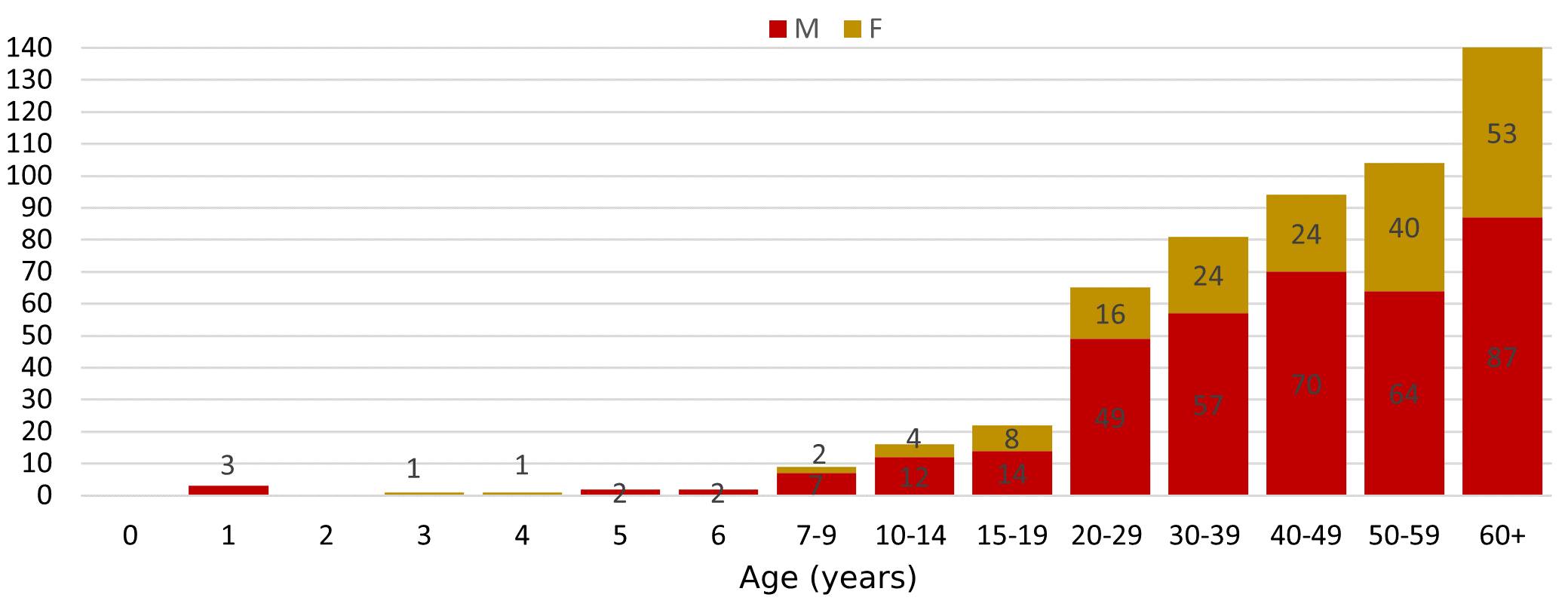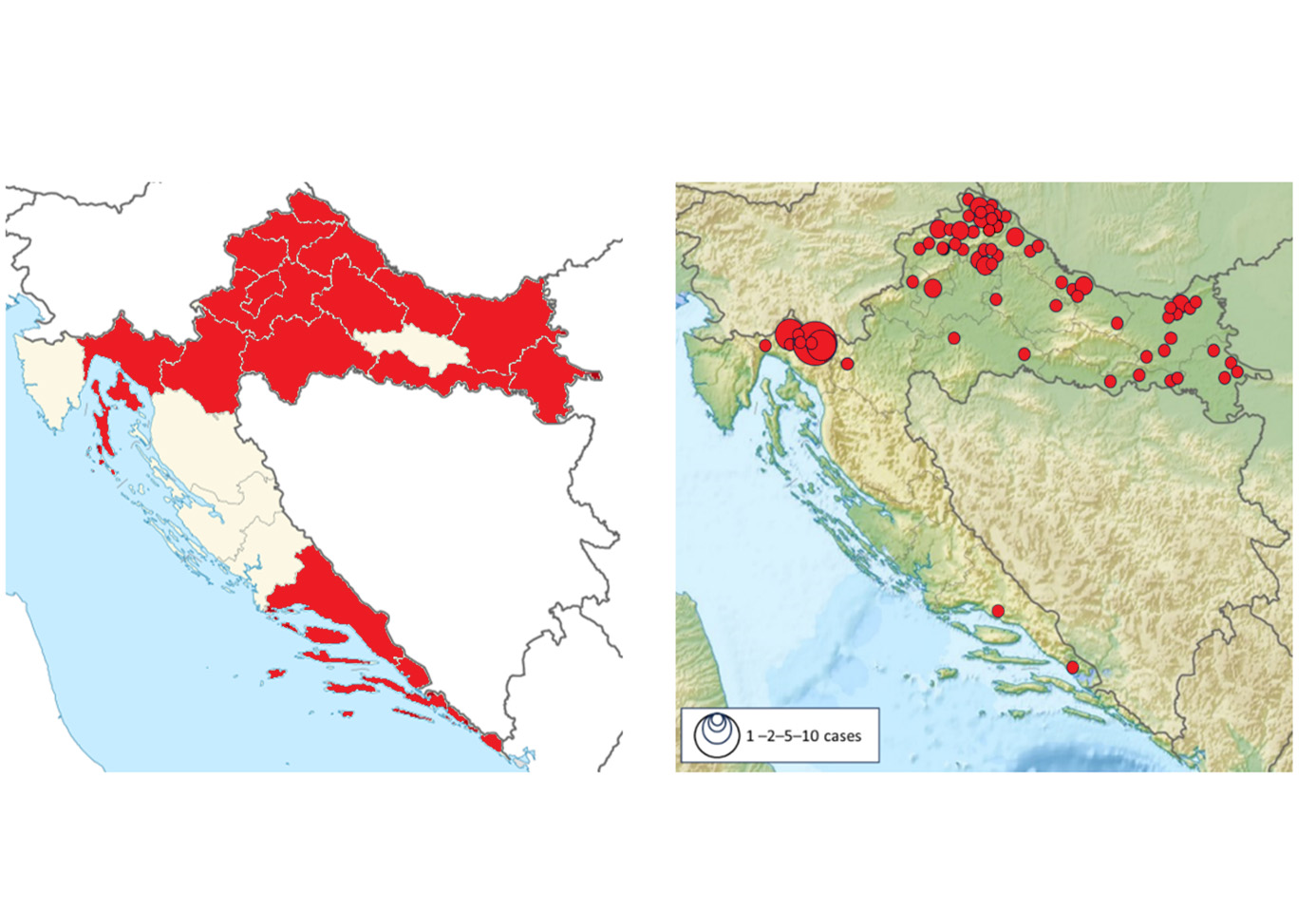Tatjana Vilibić-Čavlek, Maja Bogdanić, Vladimir Savić, Ljubo Barbić, Vladimir Stevanović
and Bernard Kaić
E-CDC risk status: endemic
(last edited date: 01.04.2024, data from 2023)
History and current situation
In Croatia, TBE was reported for the first time in 1953 near Križevci (Stara Ves, northwestern region).1 In addition to this first focus, several continental foci (Bjelovar, Pakrac, Koprivnica, Karlovac, Varaždin) have been recorded since 1961. Moreover, TBEV antibodies were detected in residents of the Croatian littoral near the islands of Zadar, Pula, and Brac.2 In 1991, TBEV emerged in the mountainous area of Gorski Kotar.3 The disease is also endemic in northwestern and eastern regions between the Sava and Drava rivers. Endemicity is highest in northwestern counties, with average incidence rates ranging from 3.61 to 6.78 per 100,000 inhabitants.4,5 In 2015 and 2019, two TBE clusters after consumption of raw goat milk were observed.6,7
TBE in Croatia shows a bimodal seasonality with a larger peak during the spring and summer months (April–August) and a smaller one in October–November. A recent study showed that the majority of TBE patients are in the age group of 40–69 years (58.3%) with a male predominance (70.2%). Males predominate in all age groups with male-to-female ratios ranging from 1.3:1 (for those under 20 years) to 5:1 (for those between 50 and 59 years). Meningitis (54.8%) and encephalitis (30.9%) are the main clinical presentations in hospitalized patients with TBE. The abortive form (“febrile headache”) was reported in 13.1% of patients, and meningoencephalomyelitis in 1.2% of patients.8
In addition to human cases, 2.1% of TBEV asymptomatic seropositive individuals were detected in the same study (2017–2023). In contrast to acute cases, there is only a comparatively small difference in the seroprevalence between males (2.6%) and females (3.6%) as well as between age groups (2.5–3.7%). Recent serosurveys showed the presence of TBEV antibodies in animals as well. Seropositive horses were detected in continental Croatian counties in the period from 2017 to 2020. The overall seroprevalence rate was 12.1%, ranging from 7.3% to 17.1%. In 2022, 9.7% of sheep from the easternmost Vukovar-Srijem county tested positive for TBEV IgG antibodies.8
Ixodes ricinus ticks are the main vector of TBEV in Croatia. From 2017 to 2023, hard ticks were sampled using the dragging–flagging method and hand-picked from both dead wild and live domestic animals. Ticks were collected in the Medvednica and Papuk mountain areas, and in the area between the Drava, Sava, and Danube Rivers. In the Alpine biogeographic region, ticks were mostly collected in the Gorski Kotar area. The seasonal tick dynamic was similar to the reported human cases.8
A study on the TBEV detection in ticks removed from red fox (Vulpes vulpes) carcasses hunted in endemic areas in northern Croatia was performed during two hunting seasons (2010-2011 and 2011-2012). TBEV was detected in adult Ixodes ricinus and Ixodes hexagonus ticks showing a prevalence of 1.6%. Furthermore, two spleen samples (1.1%) from 182 red deer (Cervus elaphus) were found positive for TBEV.9
Phylogenetic analysis of one TBEV strain detected in a urine sample from a patient with severe meningoencephalitis (2017) and strains from ticks and deer spleen showed that all clustered the TBEV European subtype.4,9
Overview of TBE in Croatia
| Table 1: TBE in Croatia | |
|---|---|
| Viral subtypes isolated | TBEV European subtype4,8 |
| Reservoir animals | Rodents |
| Infected tick species (%) | 1.6% in one study |
| Dairy product transmission | 2015 – 7 cases of TBEV (Bjelovar region) after consuming fresh goat milk and cheese6 2019 – 5 cases of TBEV (Gorski Kotar region) after consuming raw goat milk from the same farm7 |
| Case definition used by authorities | ECDC case definition10 |
| Type of reporting | Mandatory11 |
| Other TBE-surveillance | Occasionally serosurveys8 |
| Special clinical features | The majority of cases are in the age group 40–69 years. Meningitis (54.8%) and encephalitis (30.9%) are the most common clinical presentations in hospitalized patients. An abortive form “febrile headache” was detected in 13.1% of patients.8 |
| Licensed vaccines | FSME-IMMUN |
| Vaccination recommendations | Risk groups (forestry workers, hunters, people who reside in endemic areas/visit endemic areas) |
| Vaccine uptake | No data |
| National Reference center for TBE | National Reference Laboratory for Arboviruses, Reference Center for Diagnosis and Surveillance of Viral Zoonoses of the Croatian Ministry of Health, Department of Virology, Croatian Institute of Public Health |
Figure 1: TBE cases notified over time, 1987–2023

Click the image above to enlarge
Preliminary data for 2023, reporting is still ongoing until April 2024
Source: Reference Center for Epidemiology Croatian Ministry of Health; Croatian Institute of Public Health
Figure 2: Age and gender distribution of notified TBE cases in Croatia, 2000–2020

Click the image above to enlarge
Source: Reference Center for Epidemiology Croatian Ministry of Health; Croatian Institute of Public Health
Figure 3: Sites of TBEV detection in Croatia, 2016–2023

Click the image above to enlarge
Red shadowed areas: counties with reported cases;
Red circles: Cumulative infection sites of TBE patients for the period from 2016 to 2023
Source: Vilibic-Cavlek T, et al. Microorganisms. 2024; 12(2):386.
Figure 4: Seasonal dynamic of Ixodes ricinus ticks in Croatia, 2016–2023

Source: Vilibic-Cavlek T, et al. Microorganisms. 2024; 12(2):386.
Acknowledgments
TBE surveillance was supported by the projects: Croatian Science Foundation, project IP 2016-06-7456: Prevalence and molecular epidemiology of emerging and re-emerging neuroinvasive arboviral infections in Croatia; CRONEUROARBO (2017-2021), and the Next Generation EU project supported by Ministry of Science and Education of the Republic of Croatia, grant number NPOO 1 of the Croatian Veterinary Institute: Epidemiology of avian flaviviruses in the “One Health” context, FLAVIR.
Contact
Tatjana Vilibić-Čavlek
tatjana.vilibic-cavlek@hzjz.hr
Authors
Tatjana Vilibić-Čavlek, Maja Bogdanić, Vladimir Savić, Ljubo Barbić, Vladimir Stevanović and Bernard Kaić
Citation
Vilibić-Čavlek T, Bogdanić M, Savić V, Barbić L, Stevanović V and Kaić B. TBE in Croatia. Chapter 13. In: Dobler G, Erber W, Bröker M, Chitimia-Dobler L, Schmitt HJ, eds. The TBE Book. 7th ed. Singapore: Global Health Press; 2024. doi:10.33442/26613980_13-7-7
References
- Vesenjak-Hirjan J. Tick-Borne Encephalitis in Croatia. Rad JAZU, Book 372; Croatian Publisher RAD JAZU: Zagreb, Croatia, 1976; pp. 1–10.
- Vesenjak-Hirjan J, Galinović-Weisglass M, Brudnjak Z. Infections with Tick-Borne Encephalitis Virus in Pannonian Focus Stara Vas. Serological Studies in 1972; Rad JAZU, Book 372; Croatian Publisher RAD JAZU: Zagreb, Croatia, 1976; pp. 29–36.
- Borčić B, Kaić B, Gardasević-Morić L. Krpeljni meningoencefalitis u Gorskom kotaru–nove spoznaje [Tick-borne meningoencephalitis in Gorski Kotar–new findings]. Lijec Vjesn. 2001; 123(7-8):163-4.
- Vilibic-Cavlek T, Barbic L, Mrzljak A, Brnic D, Klobucar A, Ilic M, et al. Emerging and Neglected Viruses of Zoonotic Importance in Croatia. Pathogens 2021; 10:73. doi:10.3390/pathogens10010073
- Vilibic-Cavlek T, Janev-Holcer N, Bogdanic M, Ferenc T, Vujica Ferenc M, Krcmar S, Savic, et al. Current status of vector-borne diseases in Croatia: Challenges and Future Prospects. Life. 2023;13(9):1856. doi:10.3390/life13091856.
- Markovinović L, Kosanović Ličina ML, Tešić V, Vojvodić D, Vladušić Lucić I, Kniewald T, Vukas T, Kutleša M, Krajinović LC. An outbreak of tick-borne encephalitis associated with raw goat milk and cheese consumption, Croatia, 2015. Infection 2016; 44(5):661-5. doi:10.1007/s15010-016-0917-8
- Ilic M, Barbic L, Bogdanic M, Tabain I, Savic V, Kosanovic Licina ML, et al. Tick-borne encephalitis outbreak following raw goat milk consumption in a new micro-location, Croatia, June 2019. Ticks Tick Borne Dis. 2020; 11(6):101513. doi:10.1016/j.ttbdis.2020.101513
- Vilibic-Cavlek T, Krcmar S, Bogdanic M, Tomljenovic M, Barbic L, Roncevic D, et al. An Overview of Tick-Borne Encephalitis Epidemiology in Endemic Regions of Continental Croatia, 2017-2023. Microorganisms 2024; 12(2):386. doi:10.3390/microorganisms12020386
- Jemeršić L, Dežđek D, Brnić D, Prpić J, Janicki Z, Keros T, Roić B, Slavica A, Terzić S, Konjević D, Beck R. Detection and genetic characterization of tick-borne encephalitis virus (TBEV) derived from ticks removed from red foxes (Vulpes vulpes) and isolated from spleen samples of red deer (Cervus elaphus) in Croatia. Ticks Tick Borne Dis. 2014; 5(1):7-13. doi:10.1016/j.ttbdis.2012.11.016
- Croatian Institute of Public Health. [Definitions of infectious diseases that are mandatory reported]. Accessed 16 April, 2024. https://www.hzjz.hr/wp-content/uploads/2023/04/definicije-24_01_2024_promjenaCOVID19.pdf (In Croatian)
- Ministry of Health of the Republic of Croatia. [List of infectious diseases which control and prevention are of interest to the Republic of Croatia]. Accessed 16 April, 2024. https://narodne-novine.nn.hr/clanci/sluzbeni/2014_05_60_1119.html